Pakistan was one of the first countries to introduce Islamic banking with efforts to Islamize the economy started in the mid-60s as a response to both religious and economic needs. After two attempts to implement Islamic banking in the country, it is now an established industry with 13% market share. This growth is supported by strong support from the State Bank of Pakistan to promote Islamic finance, new regulations on Islamic banking, new industry-supporting regulatory bodies, as well as rising demand from foreign investors and the large Muslim population.
Economy at a Glance
Pakistan is a fast-growing emerging market and a major economy within the countries of the Organization of Islamic Cooperation (OIC). As the second-largest economy in South Asia, Pakistan is predicted to be the world’s fastest-growing Muslim economy in 2017 ahead of Indonesia, Malaysia, Turkey and Egypt, according to “The Economist” magazine. The game changer for Pakistan is the investment from the China-Pakistan Economic Corridor (CPEC) initiative that envisages a US$45 billion investment in infrastructure projects that include roads, railways and power plants. This ambitious project – part of China’s “One Belt and One Road” or new Silk Road project – is a series of roads, railways, pipelines, hydropower plants and other development projects, being built from the Xinjiang province in China to Gwadar in southwestern Pakistan.
With this multi-billion worth of infrastructure projects under CPEC, the opportunities to offer sukuk for infrastructure and demand for Islamic project financing are expected to grow significantly. The first CPEC transaction, a US$1.95 billion loan syndication was financed mostly by large Chinese banks. But the deal featured two Shari’a-compliant tranches worth a combined PRK16 billion extended by Faysal Bank, Meezan Bank and Habib Bank. The IMF predicts that the CPEC will boost Pakistan’s economy, where the GDP is expected to grow by more than five percent by 2020. By 2050, Pakistan’s GDP is anticipated to reach US$4.2 trillion from the current US$988 billion. The CPEC provides tremendous opportunity for Islamic finance in Pakistan.
Regulations Governing Islamic Banking and Finance
Islamic or interest-free banking was implemented in Pakistan in the 1980’s through several pioneering work on legal and regulatory fronts that called for the elimination of riba from the banking system and the full Islamisation on the country’s economy. These included amendments to the Banking Companies Ordinance (BCO-1962) to accommodate non-interest based transactions, enactment of Modaraba Companies and Modarabas Ordinance 1980 to introduce mudaraba as a two-tier fund structure for undertaking Shari’a-compliant businesses, the amendments of Banking and Financial Services Ordinance 1984 as well as the Banking Tribunals Ordinance 1984 to provide a new system of recovery of non-interest based modes of financing and issuance of BCD Circular No. 13 of 1984 by the State Bank of Pakistan (SBP) that called for the elimination of riba from the banking system.
In a dramatic turn of event, Islamic banking practices were challenged in the Federal Shariat Court (FSC) and subsequently, they were declared as ‘not according to the principles of Islam’ in November 1991. This decision was later upheld by the Shariat Appellate Bench (SAB) of Supreme Court of Pakistan after appeals were made by the government and financial institutions were rejected. In line with directives of SAB, the government constituted a high-level Commission and a number of tasks forces and Committees to study the prospects of transforming Pakistan’s financial system from an interest-based to Shari’a-compliant and to draw up the transformation plan. As a result, Islamic banking was re-launched in 2001 as a parallel system wherein both Islamic and conventional banks are allowed to operate alongside one another, rather than full Islamisation of the economy as per earlier attempts. A more gradual and steady approach was also adopted in the development of Islamic banking in the country as stated in the Islamic Banking Policy of the State Bank of Pakistan (SBP) issued in 2001.
Although there is no specific enabling legislation for Islamic banking in the country, Pakistan has specific regulation and provision under the general market regulation for Islamic finance. Pakistan amended laws to accommodate Islamic finance since the early days of Islamic banking. However, these changes had very limited success due to the unavailability of adequate infrastructure, lack of trained human resources and a ruling by Federal Sharia Court (November 1991) declaring the procedures adopted by banks as un-Islamic. However, the biggest milestone in the development of the Islamic banking industry in the country was the introduction of the Islamic Banking Policy in December 2001. The policy adopted a three-pronged approach to develop the Islamic banking whereby banks were allowed to offer Islamic financial services under three structures: (i) full-fledged Islamic banks, (ii) Islamic banking subsidiaries of conventional banks and (iii) standalone Islamic banking branches (IBBs) of conventional banks. With this renewed focus and strategy, the first full-fledged Islamic bank, Meezan Bank, was established in 2003. This paved for a new era of Islamic banking in Pakistan.
The SBP also issued policies for the formalization of Islamic banking practices in 2003. These included stipulating eligibility criteria, licensing requirements, and producing guidelines on the physical set up along of the bank, Shari’a compliance procedures and other operational matters of the banks. In January 2003, a circular detailing instructions on the setting up of subsidiaries and stand-alone Islamic banking branches by existing commercial banks were issued. Although the policy provided provisions for the establishment of Islamic banking subsidiaries, there was no operational subsidiary in the country up until 2014.
Risk management guidelines for Islamic banking institutions based on Islamic Financial Services Board (IFSB) standards were issued in 2008. These guidelines cover all major risk categories while providing best practices for establishing and implementing risk management in Islamic banking institutions. Guidelines on Islamic Financing for Agriculture was issued in 2009, which aims to help banks develop specific Shari’a-compliant products to meet the financing needs of the farming community. The guidelines broadly cover Islamic modes of financing that can be used for meeting the financing requirements of farming and non-farm activities including livestock, fisheries, poultry and orchards.
Banking Institutions were issued in 2012 replacing the 2008 “Instructions & Guidelines for Shari’a Compliance in Islamic Banking Institutions”. These instructions require Islamic banking institutions to have in place a well-defined pool management framework for the creation and management of pools with each pool having distinct objectives and risk reward features, which is to be managed as a virtual enterprise having clearly identifiable assets, liabilities, income and expenses. These instructions are expected to bring transparency and standardization across industry along while safeguarding depositors’ interests.
In order to encourage conventional banks to set up Islamic subsidiaries, the initial minimum capital requirement for subsidiary was revised downwards from Rs. 10 billion to Rs. 6 billion. Subsequently, Meezan Commercial Bank was granted license from SBP to set up the first Islamic banking subsidiary. New rules for the operation of Islamic banking windows were issued by SBP in 2014, which required banks to obtain written approval from the central bank before opening each Islamic window, as well as providing the regulator with additional details on staffing, training and marketing arrangements.
A second five year plan to further boost the development of Islamic finance in Pakistan was launched by SBP in 2015. The aim of the SBP’s five-year strategic plan is to set a common direction for Pakistan’s Islamic banking industry to augment existing growth momentum and to lead the industry to the next level of development. Key focus areas of the plan that will run from 2014 to 2018 are: enabling policy environment, Shari’a governance and compliance, awareness and capacity-building and market development. The Strategic Plan envisions the industry to gain 15% share of the country’s overall banking system by 2018. Since then SBP has introduced several new rules and instructions. The latest one being IBD Circular No. 01 of 2016 dated September 7, 2016. With this circular, Islamic banks are now allowed to benchmark their products based on participatory modes – known as musharaka and mudaraba – and wakala-based agency, with respect to an index other than the Karachi Inter Bank Offered Rate or KIBOR. However, they are required to outline their alternative pricing mechanism for participatory financing schemes. This recent decision by the central bank will allow Islamic banking to be more Shari’a authentic and pave the way for development of Shari’a-compliant pricing benchmark by Islamic banking institutions in near future.
The first takaful regulatory framework was developed in Pakistan in the shape of Takaful Rules 2005. Issued by the Securities Exchange and Commission of Pakistan (SECP), the rules state that only a full-fledged takaful company is allowed to operate in the country. According to Section 8 of the Takaful Rules, the principal operational model for insurance risk management and the investment component shall be based on the concept of wakala and mudaraba. With this framework in placed, the first takaful group, Pak-Kuwait Takaful, began operations in 2005. In a bid to boost competition and increase market penetration, the SECP introduced Takaful Rules 2012, which among other things allowed conventional insurance companies to open takaful windows. The law also included provisions to allow the establishment of a central Shari’a board at SECP to regulate the industry’s risk management and rating procedures.
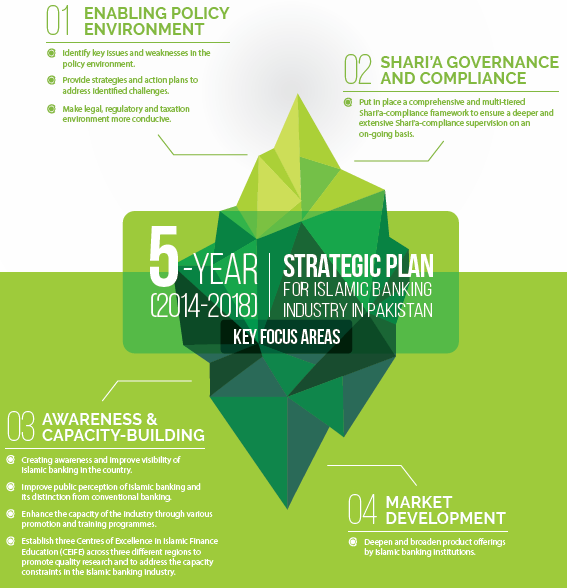
In October 2016, the SECP approved amendment to the Rule 10(1)(s) of the Takaful Rules, 2012, which now allow takaful operators to participate on co-takaful basis with conventional insurers under the lead of a conventional insurer. A “Directive for Life Insurance and Family Takaful Illustrations, 2016″ was issued by SECP in March 2016 with the objective of bringing uniformity among insurers and takaful companies in presenting illustrative values, to make illustrations more understandable and to ensure that illustrations do not mislead purchasers of life insurance products. The directive provides details on illustration format, prescribe standards to be followed when illustrations are used and specifies the disclosures that are required for illustrations. Hence, under this directive the word ‘takaful’ may be used interchangeably with the word ‘insurance’, ‘Family takaful’ with ‘Life insurance’, ‘contribution’ with ‘premium’, ‘insured’ with ‘policyholder’ and ‘company’ and ‘insurer’ with ‘takaful operator’.
The establishment and operations of Modarabas Companies are governed by several regulatory framework under the SECP including the Modaraba Companies & Modaraba (Floatation & Control) Ordinance, 1980 and Modaraba Companies and Modarabas Rules 1981. The Ordinance and Rules provide matters relating to the registration of Modaraba Companies and the floatation, management and regulation of Modarabas. Other rules and regulations that are applicable to Modaraba Companies and Modarabas are Prudential Regulations for Modarabas and Companies Ordinance 1984.
In a major move to strengthen and provide a level playing field to the country’s non-banking financial sector including Modarabas, the SECP issued revised Prudential Regulations for Modarabas in 2004 following the issuance of prudential regulations for Non-Banking Finance Companies (NBFCs). It was envisaged that this would contribute towards improving the risk management capabilities and promoting corporate governance in the Modaraba sector. The revised regulations were divided into four segments that covers (a) comprehensive definitions of all the key activities of Modarabas, (b) guidelines for risk management in respect of corporate and individual borrowers, (c) operations of Modaraba and (d) Know Your Customers (KYC) and anti-money laundering issues.
A ‘Fit and Proper Criteria’ for Modarabas and their management companies were issued by SECP via Circular No 10 of 2008, which is applicable to the sponsors and promoters of a Modaraba Company, Modaraba and the Chief Executive, Directors and key executives of the Modaraba company. Prior to issuance of this Circular, the Prudential Regulations for Modaraba did not provide any guidelines for fitness and propriety of promoters and appointment of executives of a Modaraba company or a Modaraba. Similarly, the Regulations did not prescribe a thorough and comprehensive approach for evaluation of credentials of the proposed Chief Executive or Director or executives. The Shariah Compliance Guide for Modarabas was introduced in 2012 which serves as a guidelines for policies, procedures and strategies to ensure that the business operations of the Modarabas are Shari’a-compliant.
In 2015, the SECP issued the Modaraba Regulations 2015. The Modaraba rules outline the criteria for the issuance of certificate of investments, dictate the level of exposures a Modaraba may undertake, and specify Shari’a-compliance requirements among others. The rules also specify that a Modaraba is only eligible to issue investment certificates after obtaining a minimum credit rating of ‘A-’ and has been in operation for at least three years and has shown profits in the last two years. Further, a Modaraba is not allowed to invest more than 5% of its (or investee company’s) paid-up capital in a particular institution’s equities.
A draft bill on amendments to the Modaraba Companies and Modaraba (Floatation and Control) Ordinance, 1980 was issued by SECP in 2016. The proposed amendments intended to reflect the rapid and extensive changes in the business of modarabas. The major amendments to the ordinance include the prohibition on the use of the word ‘modarabas’ or any of its derivatives by any person other than a Modaraba Company in order to curb for any illegal business activity. This is in response to the increasing cases involving Modaraba scams nationwide. Other new provisions proposed include provisions for empowerment of the Modaraba certificate holders and prohibition on deposit raising by modarabas. The appointment of Shari’a advisers by Modarabas will be made mandatory under the proposed bill.
The first draft on sukuk regulations was introduced in 2012 by the SECP and updated in 2015. The Sukuk Regulations 2015 prescribe pre-conditions for sukuk issuance and the eligibility criteria for the issuers in which the issuer must have a rating of at least BBB and the instrument should not rate lower than BBB. In addition to the disclosure and reporting requirements, the regulations also require the appointment of a Shari’a adviser and an investment agent and state that sukuk are to be structured in compliance with Accounting and Auditing Organization of the Islamic Financial Institutions (AAOIFI) standards. In a landmark decision by Pakistan’s Federal Board of Revenue in September 2016, the government has accorded tax neutrality to sukuk by allowing certain tax exemptions that were earlier available only to conventional securitization issues. Under the previous tax treatment, sukuk transactions are imposed double taxation as special purpose vehicles (SPVs) are subject to stamp duty tax and capital value tax. Thus, making it considerably more expensive for companies to issue sukuk than conventional bonds and hence, making sukuk an “unviable” funding option. With this new tax incentive in placed, it is expected to give a great boost to the Islamic financial industry and the overall growth and development of the sukuk market in Pakistan.
Shari’a Governance
Central to regulation of Islamic financial services is an effective Shari’a governance framework, in the absence of which the confidence of general public on Islamic banking and finance may deteriorate. At the national level, Islamic banking sector is overseen by the SBP’s Centralized Shari’a Board, which was set up in 2003. Detailed Instructions and Guidelines for Shari’a-compliance in Islamic banking institutions were first issued by SBP in 2008, which provided guidance in areas such as Shari’a-compliance, internal Shari’a audit, investment in shares, policy for profit distribution with Profit & Loss Sharing account holders, financial reporting and general disclosure, etc. Against the backdrop of the many developments taking place since the first guidelines were introduced, a new Shari’a governance framework was issued in 2015 to further strengthen the Shari’a-compliance environment of Islamic banking institutions in Pakistan. The framework explicitly defines the roles and responsibilities of various organs of Islamic banking institutions including the Board of Directors, Executive Management, Shari’a Board, Shari’a Compliance Department (SCD), internal and external auditors towards Shari’a compliance.
In addition, the framework also requires Islamic banking institutions to constitute Shari’a boards comprising at least three Shari’a scholars meeting the ‘Fit and Proper’ criteria prescribed by SBP. In order to enhance understanding of Shari’a Board’s report and for better public disclosure, all Islamic banking institutions are required to publish the Urdu translation of the report in their annual report effective from December 2016. The SBP is one of the very few central banks that carries out on-site Shari’a inspections. In efforts to increase harmonisation and standardisation of Shari’a practices, the SBP has adopted various standards issued by international standards-setting bodies such as AAOIFI Shariah Standards and prudential standards on “Risk Management”, “Corporate Governance” and “Shari’a Governance” issued by International Financial Services Board (IFSB).
Islamic Banking
The Islamic banking industry has shown significant progress since it was re-launched in 2001. The network of Islamic banking institutions in Pakistan is made up of 5 full-fledged Islamic banks and 16 Islamic branches of conventional banks with some 2,322 branches. In 2016, two Islamic banks – Burj Bank Limited and AlBaraka Bank (Pakistan) Limited merged into a single entity under the name AlBaraka Bank (Pakistan) Limited. In terms of Islamic windows, as at December 2016; there are 1,220 Islamic banking windows operated by 9 conventional banks with Islamic banking branches. Together they hold 11.7% market share of assets and 13.3% of deposits in overall banking industry after recording PKR1,853 billion and PKR1,573 billion in assets and deposits, respectively. The rapid growth in Islamic banking is reflected in growing share of Islamic banking in assets, deposits and financing of banking industry as shown in Figure 1. On the basis of current growth rate, it is expected that the industry will be able to achieve the 15% target market share by 2018.
Both total assets and deposits have recorded steady growth with a compounded annual growth rate (CAGR) of 32% and 34% from 2006 to 2016, respectively (Figure 2). The CAGR for financing and investments for the same period is at 34%. In terms of mode of financing, diminishing musharaka continues to be the leading mode for financing, followed by murabaha and musharaka (Figure 3). However, murabaha as percentage of mode of financing has been on a decreasing trend. The percentage share of murabaha financing was 16% in 2016, down from 41% in 2013. Istisna, on the other hand, registered a steady increase as a preferred mode of financing to 8.4% of total financing mix of Islamic banking institutions in 2016 from 5.6% in 2013.
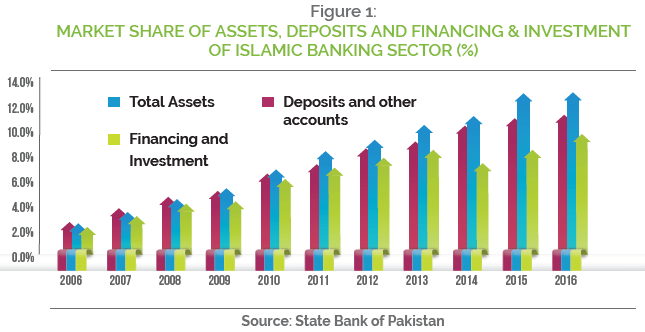
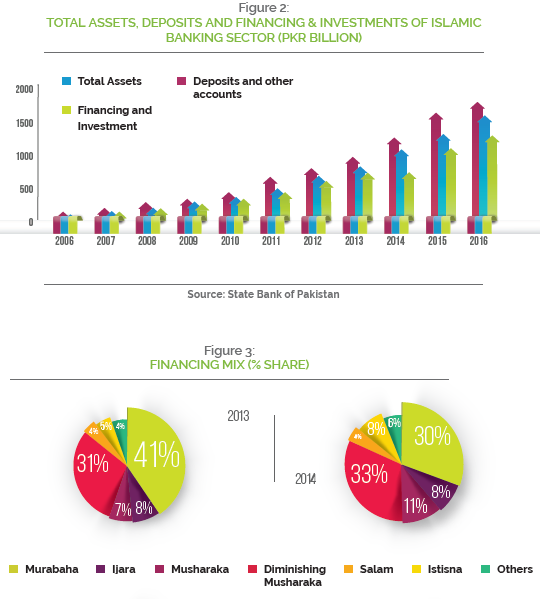

Takaful
Pakistan’s takaful sector has significant opportunities for growth as its penetration rate is still low at less than one percent of GDP. The low penetration rate of takaful in the country is due to the lack of awareness on takaful-related products as well as the issue of affordability, especially among the lower segments of the society. A total of 2 family takaful companies and 3 general takaful companies are offering Shari’a-compliant insurance products and services in the country (Table 1). Although these companies have grown substantially in the last eight years, their size relative to the conventional insurance footprint is still very small.
Takaful industry has shown a healthy growth in its gross written contribution and asset structure (Figure 4). Total assets of takaful companies at the end of 2015 amounted to PKR16, 354 million with a CAGR of 34% in the last 6 years. Gross written contribution increased from PKR8,058 million in 2014 to PKR9,326 million in 2015. Despite the continued impressive growth of takaful sector overall, this trend has not been consistent even across all product lines. Family takaful leads the Islamic insurance sector with total assets at PKR13.4 billion and gross written contribution of PKR7.8 billion in 2015 (Figure 5). This is huge contrast with general takaful with an asset size of PKR2 billion. The individual family segment represents 65% of the gross contribution, while 8% is attributable to group family insurance, and 27% by group health insurance, which is offered only by Pak Qatar Family Takaful (Figure 6). Under general takaful, motor takaful policies contribute 65% of gross written contribution, followed by fire (16%), marine (8%) and health (4%), with the remaining under the miscellaneous segment.
| NAME OF COMPANY | ||||
| TYPE OF BUSINESS | GROSS WRITTEN CONTRIBUTION | TOTAL ASSETS | PROFIT/(LOSS) (AFTER TAX) | |
| (PKR MILLION) | (PKR MILLION) | (PKR MILLION) | ||
| PAK-KUWAIT TAKAFUL | GENERAL (NON-LIFE) | 529 | 474 | (444) |
| PAK-QATAR GENERAL TAKAFUL | GENERAL (NON-LIFE) | 702 | 905 | 2.8 |
| TAKAFUL PAKISTAN | GENERAL (NON-LIFE) | 334 | 577 | 30 |
| PAK-QATAR FAMILY TAKAFUL | FAMILY (LIFE) | 6,721 | 12,099 | 81 |
| DAWOOD FAMILY TAKAFUL | FAMILY (LIFE) | 140 | 2,299 | (51) |
FINANCIAL PERFORMANCE OF TAKAFUL COMPANIES
Takaful windows began operations in 2014 and hence, are still in its infancy. As at 2016, the SECP has granted window takaful licenses to four non-life and three life conventional insurers. Gross written premium of takaful windows was PKR1.1 billion of which 69% was contributed by general takaful window (Figure 7). Overall, motor insurance is the biggest contributor to the gross written contributions of general takaful windows at 44% (Figure 8).
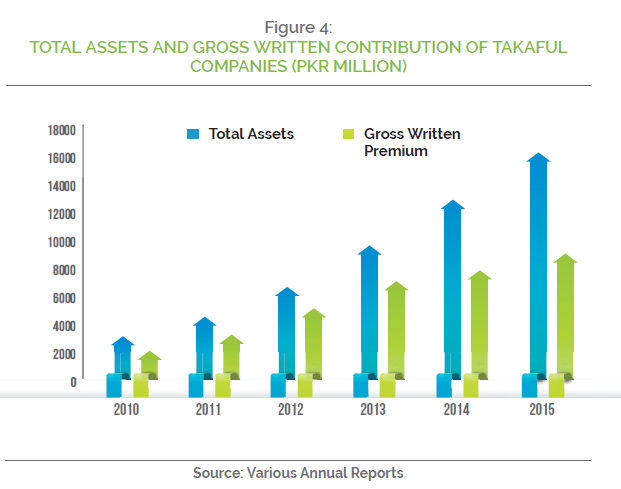

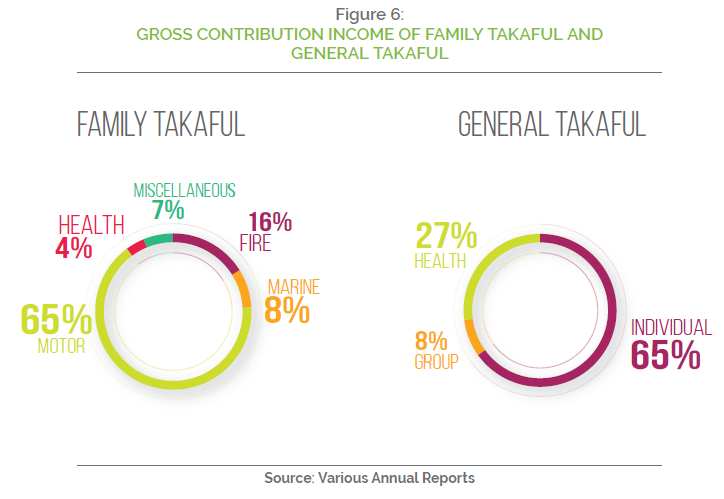
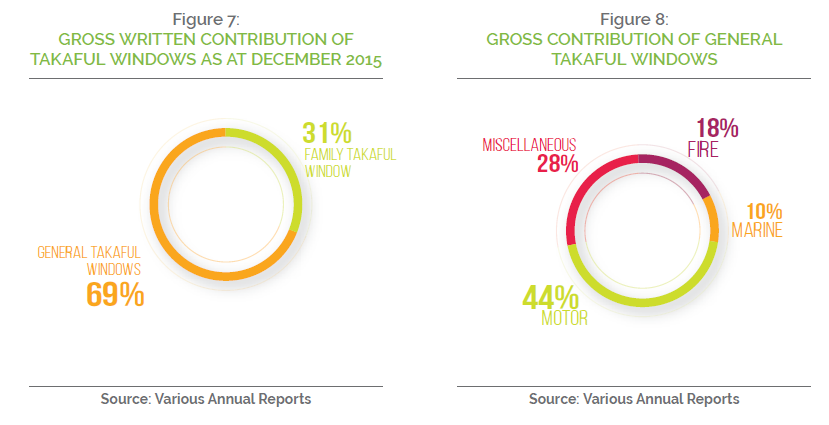
Sukuk
Sukuk market has witnessed volatility in sukuk issuance since the first sukuk made its debut in 2002. After reaching an all-time high of US$1.919 billion in 2011, value of sukuk issued fell to its lowest level ever in 2015 to a single issuance worth US$216 million before rebounding back in 2016 to reach US$1.955 billion (Figure 9). Two notable sukuk issued in 2016 were the US$1 billion sukuk ijara issued by the government in October and the PKR100 billion diminishing musharaka sukuk issued by the Pakistan Water and Power Development Authority (WAPDA) for the Neelum Jhelum Hydropower Project. As is the case with most jurisdictions where sukuk issuance is prevalent, more than 80% of sukuk issued in Pakistan was sovereign sukuk.
The latest international government sukuk issued used the M2 Motorway connecting Lahore to Rawalpindi as the underlying asset. The government hopes that the sukuk will help increase Pakistan’s overall foreign currency reserves to US$24.5 billion from US$15.4 billion as at end of 2015. The sukuk attracted some US$2.4 billion offers from 124 financial institutions with 38% coming from Europe, 27% each from North America and Middle East, 6% from Asia and remaining 2% from other parts of the world. The coupon rate was fixed at 5.5% and is said to be the lowest in the economic history of the country. The previous two international sukuk were issued in 2014 and 2005.
Sukuk in Pakistan are primarily issued for the domestic market, hence more than 80% of sukuk issuance were in rupees. In so far, only 4 international sukuk denominated in US dollar have been issued out of which one was issued by the Lahore SunCity Holding and the other 3 were issued by the government in 2005, 2014 and 2016. In terms of sukuk structure, ijara remains the most preferred structure whereby 87.5% share of the value of sukuk was structured as ijara. This is followed by musharaka structure at 12% with the remaining is shared between istisna and mudaraba.
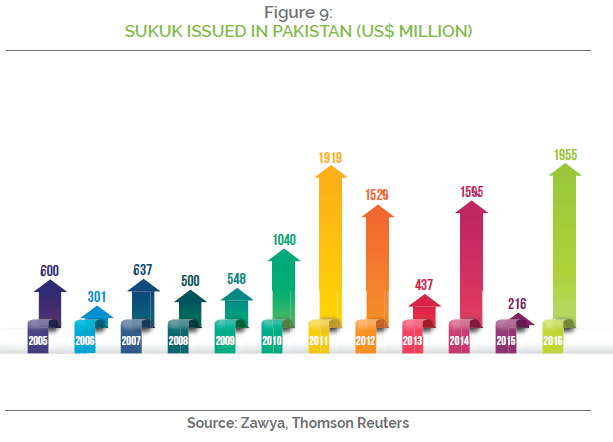
Modaraba Companies
A total of 37 modaraba companies and 25 modarabas are in operation as at end of 2016 with two new companies registered as modaraba companies while one modaraba was floated under the Modaraba Ordinance, 1980. The modaraba sector shown steady growth in assets to reach US$344.5 million as at end of 2016, representing 3.95% of total asset of the non-banking financial sector (Figure 10). About 20 modarabas declared dividend in the form of cash and bonus issue and three issued right modaraba certificates. The modaraba sector is dominated primarily by three players – Standard Chartered Modaraba, First Habib Modaraba, and Allied Rental Modaraba, whom together manage 58% of the sector’s total industry assets.
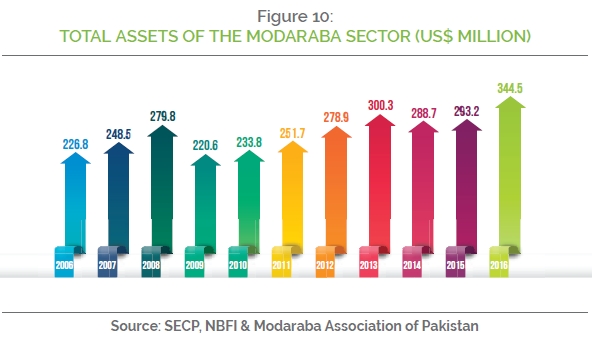
Islamic Funds
As at end of December 2016, a total of PKR242.7 billion assets were managed by Islamic mutual funds, representing 37% of the total assets under management (AuM) in the Pakistan mutual fund industry (Figure 11). In 2015, AuM outstanding stood at PKR123 billion or 29% of the total mutual fund industry. Since the first Islamic mutual fund was established in 2002, the industry has been growing at a double-digit rate. From 2010 to 2016, counterparts, AuM of Islamic mutual funds has shown a CAGR of 39.5%. There has also been a growing demand for Islamic pension products with two-thirds of assets in the country’s voluntary pension system (VPS) are now managed under Shari’a principles. At present there are 9 Islamic pension funds holding a combined PKR14.5 billion of Islamic assets or 63% of total VPS assets. This is a far cry from the PKR3.4 billion Islamic assets registered in 2013.
Islamic Microfinance
In Pakistan, nearly 100 million adults don’t have access to formal and regulated financial services, which is about 5% of the world’s unbanked population of 2 billion. In May 2015, Pakistan launched its National Financial Inclusion Strategy (NFIS), a roadmap to help the country achieve its financial inclusion goals of expanding formal financial access to at least 50% of adults, including women and youth, and to increase the percentage of SME loans in bank lending to 15% by 2020. Towards this end, Islamic microfinance as a tool of financial inclusion and social development is being offered by at least 15 institutions, which include conventional and Islamic microfinance companies, rural support programmes and non-governmental organizations, microfinance banks, cooperatives, foundations and waqf institutions. Notable ones include Akhuwat and Islamic Relief. In July 2015, the National Rural Support Programme (NRSP) Microfinance Bank became Pakistan’s first conventional microfinance institution that was granted permission by SBP to start Islamic microfinance operations.
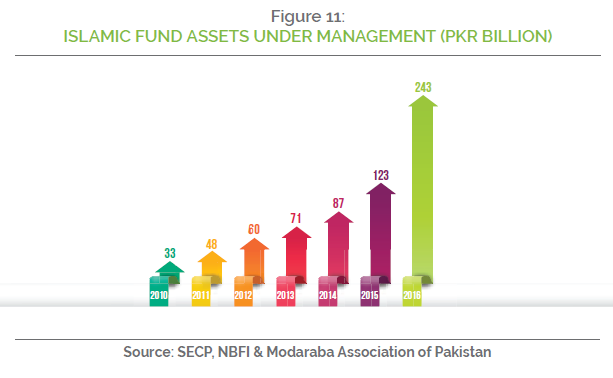
Islamic Index
In November 2015, Pakistan Stock Exchange (PSE) launched the All-Share Islamic
Index, which is the second Shari’a-compliant index developed after the introduction of the KSE – Meezan Index or KMI-30 Islamic Market Index in 2008. As the name suggests, KMI-30 index comprises 30 Shari’a-compliant stocks, listed at PSE (formerly known as Karachi Stock Exchange). Every individual stock is capped at 12% on weights and KMI-30 index is governed by Shari’a advisory board of Meezan Bank. The launched of the All-Share Islamic Index marked another significant step towards a long and sustained development of Islamic capital markets in Pakistan. The index consists of 238 companies and thus include all listed companies that currently meet the Shari’a screening criteria for the Index. Developed by the Pakistan Stock Exchange and Meezan Bank, the Index gauges the performance of the Shari’a-compliant segment of the national share market.
Islamic Finance Education
In order to promote quality research and development in the field and to address the capacity constraints in the Islamic banking industry, three Centres of Excellence in Islamic Finance were established by SBP in renowned institutions like Institute of Business Administration, Karachi (IBA), Lahore University of Management Sciences, Lahore (LUMS) and Institute of Management Sciences (IMS), Peshawar. Established across three regions, it is expected that these centres will increase the pool of skilled professionals by enhancing the number of certifications, degree programmes and training programmes related to Islamic banking and finance. Other on-going initiatives by SBP in developing talent to support the growth of Islamic finance industry is the delivery of quality training programmes by the National Institute of Banking and Finance (NIBAF), a training subsidiary of SBP.



